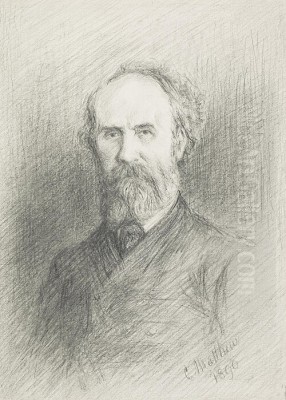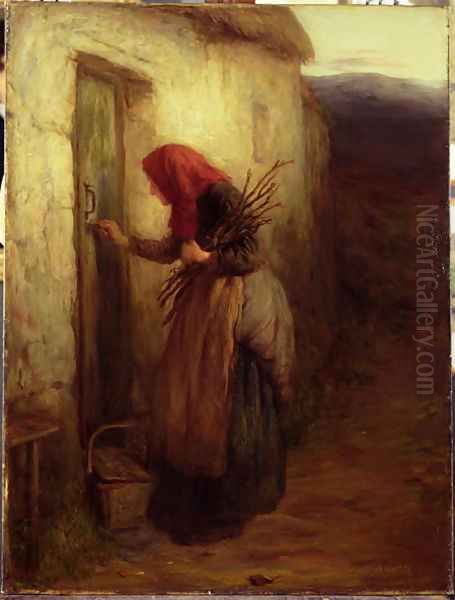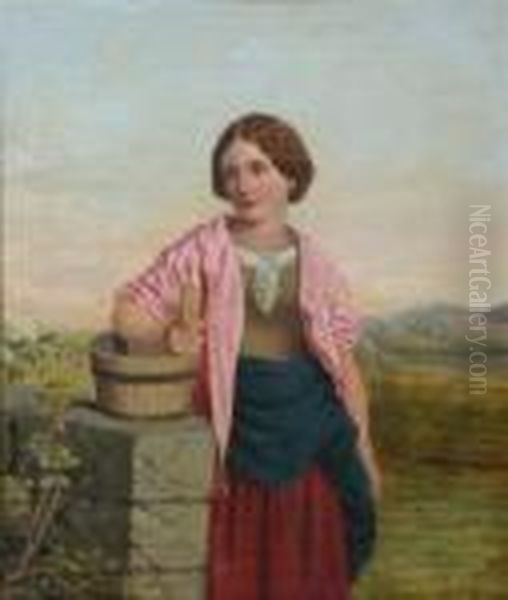
Hugh Cameron (1835-1918) stands as a significant figure in 19th-century Scottish art, renowned for his empathetic and detailed portrayals of Scottish rural life, particularly its domestic and juvenile aspects. An esteemed member of the Royal Scottish Academy, Cameron's work offers a window into the everyday experiences, joys, and hardships of ordinary Scottish people, rendered with a delicate touch and a keen observational eye. His paintings, often imbued with a gentle sentimentality, capture the character of a nation undergoing significant social and economic change, yet still deeply connected to its traditions and landscapes.
Early Life and Artistic Formation
Born in Edinburgh in 1835, Hugh Cameron's artistic journey began in the vibrant cultural milieu of Scotland's capital. His formal training took place at the Trustees' Academy in Edinburgh, a crucible for many of Scotland's most talented artists. It was here, under the influential tutelage of Robert Scott Lauder, that Cameron honed his skills. Lauder was a pivotal figure in Scottish art education, known for fostering a generation of painters who would achieve national and international recognition.
Cameron was part of a distinguished group of Lauder's students, often referred to as "The Lauder Lads," who shared a commitment to realism and a focus on Scottish themes. This group included luminaries such as William Quiller Orchardson, known for his historical and society paintings; John Pettie, celebrated for his dramatic historical genre scenes; George Paul Chalmers, a master of portraiture and genre; and William McTaggart, who would become Scotland's foremost Impressionist painter of seascapes and landscapes. The camaraderie and shared artistic exploration among these students undoubtedly played a role in shaping Cameron's own artistic path. Tom Graham was another contemporary from this talented circle.
Artistic Style and Dominant Influences
Hugh Cameron's artistic style is characterized by its gentle realism, meticulous attention to detail, and a warm, often subdued, color palette. He possessed a remarkable ability to capture subtle human emotions and the nuances of everyday life. His compositions are typically well-structured, drawing the viewer into intimate scenes without resorting to overt drama or theatricality.

A significant influence on Cameron's work was the Dutch Hague School of painters, particularly artists like Jozef Israëls. Israëls was renowned for his poignant depictions of peasant and fisherfolk life, imbued with a deep sense of humanity and often a melancholic atmosphere. Cameron shared this affinity for portraying the lives of ordinary working people with dignity and empathy. The Hague School's emphasis on atmospheric effects and the depiction of light, often filtered and soft, can also be seen in Cameron's handling of interior scenes and landscapes. Other Hague School artists like Anton Mauve, with his pastoral scenes, and the Maris brothers (Jacob, Matthijs, and Willem), each exploring different facets of Dutch life and landscape, contributed to a broader European artistic climate that valued realism and the depiction of contemporary life.
Furthermore, the influence of the French Barbizon School, particularly Jean-François Millet, is evident in Cameron's approach. Millet's elevation of peasant labor to a subject of profound artistic and social significance resonated with many artists across Europe, including Cameron. Works like Millet's "The Gleaners" or "The Angelus" found echoes in Cameron's desire to portray the quiet dignity of rural toil. The Barbizon painters, including Théodore Rousseau and Jean-Baptiste-Camille Corot, with their commitment to direct observation of nature and rural life, provided a powerful counterpoint to academic historical painting.
Key Themes in Cameron's Oeuvre
Throughout his career, Hugh Cameron consistently explored several interconnected themes, all rooted in his deep observation of Scottish life.
Rural and Domestic Life:
A central preoccupation for Cameron was the depiction of Scottish rural existence. He painted scenes of farm laborers, cottage interiors, and families engaged in daily chores. These works often highlight the simplicity and hardships of country life, but also its quiet joys and strong community bonds. His interiors are particularly noteworthy for their careful rendering of light and texture, creating a sense of intimacy and lived experience. He avoided romanticizing poverty, instead offering a respectful and honest portrayal of his subjects.
Childhood and Innocence:
Cameron had a particular gift for painting children. His depictions of young boys and girls are characterized by their naturalism and tenderness. He captured children at play, in moments of quiet contemplation, or assisting with family tasks. These works often evoke a sense of nostalgia and the universal experiences of childhood. Unlike some Victorian painters who veered into excessive sentimentality, Cameron's portrayals of children generally maintained a sense of authenticity and genuine affection. His ability to capture the unselfconscious grace of youth was widely admired.
Coastal Communities:

Given Scotland's extensive coastline, it is not surprising that maritime themes also featured in Cameron's work. He painted scenes of fisherfolk, their families, and life in coastal villages. These paintings often convey the resilience of communities dependent on the sea, and the ever-present relationship between humanity and the natural elements. Works like "By the Seashore" suggest his interest in capturing the unique atmosphere of these coastal environments and the lives intertwined with them.
Notable Works
Several paintings stand out in Hugh Cameron's body of work, exemplifying his style and thematic concerns.
"A Lonely Life" (1873):
Perhaps one of Cameron's most famous and poignant works, "A Lonely Life" depicts an elderly woman, likely a crofter, in a sparse, humble interior or engaged in a solitary outdoor task like gathering firewood. The painting evokes a profound sense of solitude, resilience, and the quiet dignity of old age in the face of hardship. The subdued palette and the focus on the figure's expressive posture and face convey a powerful emotional narrative. This work is often cited as an example of his ability to tell a story with minimal elements, relying on empathy and keen observation. It was notably painted for his friend and patron, John McGavin, a discerning collector.
"Going to the Hay" (1858):
An earlier work, "Going to the Hay," captures a more idyllic aspect of rural life. It likely depicts figures, perhaps a family or farm workers, making their way to the hayfields, a common seasonal activity. Such paintings celebrate the rhythms of agricultural life and the connection between people and the land. This work showcases Cameron's skill in figure painting and his ability to create a harmonious composition within a landscape setting. It reflects the broader 19th-century interest in pastoral themes, but with a distinctly Scottish character.
Other Significant Pieces:
Titles such as "Maternal Care," "Rummaging," and "By the Seashore" further illustrate the range of Cameron's subject matter. "Maternal Care" undoubtedly focused on the tender bond between mother and child, a recurring motif in his art. "Rummaging" might depict children exploring or a scene of domestic activity, showcasing his eye for everyday incidents. "By the Seashore" would have allowed him to explore the coastal landscapes and the lives of those who lived by the sea, a theme popular among Scottish artists. His illustrations for editions of William Cowper's poems also demonstrate his versatility and his ability to translate literary themes into visual form.
Professional Affiliations and Exhibitions

Hugh Cameron was a respected member of the Scottish artistic establishment. His talent was recognized early in his career, leading to his election as an Associate of the Royal Scottish Academy (ARSA) in 1860. He achieved full academician status (RSA) in 1869, a testament to his standing among his peers. The Royal Scottish Academy was, and remains, the premier institution for contemporary art in Scotland, and membership was a significant honor.
Beyond his involvement with the RSA, Cameron was instrumental in the formation of another important artistic body. In 1878, he co-founded the Royal Scottish Society of Painters in Water Colours (RSW). This initiative highlighted the growing importance of watercolor as a medium and provided a dedicated platform for artists working in this demanding technique. Cameron himself was a skilled watercolorist, and his participation underscored his commitment to advancing Scottish art in various forms.
Cameron's work was not confined to Scottish venues. He also exhibited at the prestigious Royal Academy in London, bringing his depictions of Scottish life to a wider British audience. Regular exhibition at such prominent institutions was crucial for an artist's reputation and commercial success during this period. His works also found their way into significant public collections, including prints held by the British Museum, ensuring their accessibility to future generations. The National Galleries of Scotland also hold examples of his work, recognizing his contribution to the nation's artistic heritage.
Contemporaries and the Artistic Milieu
Hugh Cameron worked during a dynamic period in British and European art. In Scotland, the legacy of earlier genre painters like Sir David Wilkie, who had achieved international fame for his scenes of Scottish life, provided a foundation for artists like Cameron. However, Cameron and his contemporaries, particularly the "Lauder Lads," brought a new sensibility to their work, influenced by contemporary European trends.
His friendship with John McGavin, a Glasgow-based collector, is particularly illuminating. McGavin was a significant patron not only of Cameron but also of other leading artists of the day. His collection included works by Cameron's fellow Lauder students, William Quiller Orchardson and John Pettie. Importantly, McGavin also collected works by major French Barbizon School painters like Jean-Baptiste-Camille Corot and Jean-François Millet, and Hague School artists such as Jozef Israëls and one of the Maris brothers. This connection suggests a shared taste and an informed appreciation for the realist and naturalist movements that were shaping European art. Other artists in McGavin's circle of interest included the French painter Narcisse Virgilio Díaz de la Peña, also associated with the Barbizon school.
While Cameron's style remained rooted in a more traditional form of realism, he was working at a time when new artistic movements were emerging. The later part of his career coincided with the rise of the Glasgow Boys, a group of Scottish painters including James Guthrie and Sir John Lavery, who embraced a more radical, plein-air approach influenced by French Naturalism and Impressionism. Although Cameron's work differed in style from the Glasgow Boys, he shared their commitment to depicting Scottish subjects with authenticity.
Later Life and Enduring Legacy
Hugh Cameron continued to paint throughout his long life, remaining dedicated to his chosen themes and maintaining a high standard of craftsmanship. He passed away in 1918, at the age of 83, leaving behind a significant body of work that documents and celebrates the life of his time.
His legacy lies in his sensitive and insightful portrayal of 19th-century Scottish rural and domestic life. He was a painter of the people, capturing their everyday struggles, simple pleasures, and enduring spirit with honesty and affection. His focus on children, rendered with particular tenderness, adds a unique dimension to his oeuvre. Cameron's work provides valuable historical and social insights, but its lasting appeal also stems from its artistic merit – his skilled draftsmanship, subtle use of color and light, and his ability to convey emotion and narrative with quiet power.
In the broader context of Scottish art, Hugh Cameron holds a distinguished place as a key figure in the tradition of genre painting. He successfully blended meticulous observation with a gentle, empathetic vision, creating works that continue to resonate with viewers today. He stands as a testament to the rich artistic talent that flourished in Scotland during the Victorian era, contributing significantly to the nation's cultural heritage. His paintings remain a cherished record of a way of life, seen through the eyes of a deeply perceptive and humane artist.
Conclusion
Hugh Cameron RSA RSW was more than just a painter of scenes; he was a storyteller in paint, a quiet observer who found beauty and significance in the ordinary. His dedication to portraying the lives of Scottish people, particularly those in rural settings and the intimate sphere of the family, has left an invaluable artistic legacy. Influenced by both his Scottish training under Robert Scott Lauder and broader European artistic currents like the Hague and Barbizon Schools, Cameron forged a distinctive style characterized by its realism, empathy, and technical skill. Through works like "A Lonely Life" and his many depictions of childhood, he captured the heart of his nation, ensuring his place as one of Scotland's most beloved 19th-century artists.